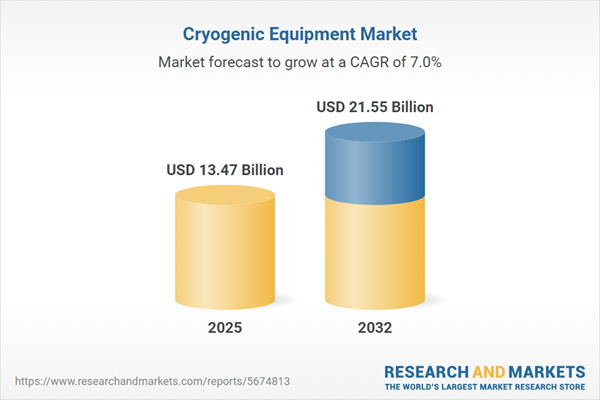Speak directly to the analyst to clarify any post sales queries you may have.
In the evolving landscape of industrial processing, the cryogenic equipment market is witnessing significant momentum as organizations prioritize operational efficiency and reliability in low-temperature environments. Senior leaders across sectors are actively seeking solutions that address both regulatory and performance pressures while unlocking long-term growth opportunities.
Market Snapshot: Cryogenic Equipment Market Size and Growth Outlook
The global cryogenic equipment market continues to expand, registering strong top-line growth and a steady compound annual growth rate. This performance underscores increasing adoption across healthcare, electronics, industrial manufacturing, and energy sectors, as organizations implement advanced systems to support vital cold-chain and production objectives.
Scope & Segmentation: Strategic Dimensions of the Cryogenic Equipment Market
- Product Types: Includes pumps (centrifugal, reciprocating), storage tanks (various capacities below 1,000 liters, 1,000–3,000 liters, and above 3,000 liters), transfer hoses (less than 5 meters, 5–10 meters, over 10 meters), and vacuum jacketed pipes.
- Cryogen Types: Covers liquid argon, liquid nitrogen, and liquid oxygen, each chosen for specific thermal, purity, and application criteria.
- End Use Industries: Encompasses electronics (displays, semiconductors), food processing, healthcare (hospitals, research labs), and industrial manufacturing (automotive, chemical processing, metal fabrication).
- Distribution Channels: Features direct sales (manufacturers, OEM partnerships), authorized and independent distributors, and online sales channels.
- Application Areas: Spans filling and transfer, storage (bulk and cylinder), and secure transportation (ISO containers, road tankers).
- Regional Coverage: Key markets include North America, Latin America, Europe, the Middle East, Africa, and Asia-Pacific, with further detail into countries such as the United States, Germany, China, India, and Brazil.
- Leading Companies: Assessed organizations include Air Liquide S.A., Linde plc, Air Products and Chemicals, Inc., Chart Industries, Inc., Messer Group GmbH, Taiyo Nippon Sanso Corporation, Cryogenic Industries, Inc., Cryoport, Inc., Cryostar SAS, and Technifab Products, Inc.
Cryogenic Equipment Market Key Takeaways
- Digital integration is rapidly reshaping equipment management, with real-time monitoring and predictive maintenance minimizing downtime and supporting lifecycle optimization.
- Material science advances, including enhanced insulation and vacuum technologies, are driving greater thermal efficiency and modular design, enabling faster adaptation to evolving industry requirements.
- Sustainability initiatives prompt a transition towards modular, upgradable components, reducing waste and positioning manufacturers to meet decarbonization targets.
- Stringent safety protocols and shifting regulation, particularly around liquid oxygen handling, necessitate continuous updates to quality assurance and certification processes.
- Regional market dynamics vary, with healthcare growth in Asia-Pacific and sustainability mandates in Europe significantly influencing demand and product configurations.
- Strategic collaborations, mergers, and targeted investments in service networks are central to the competitive strategies of market leaders, supporting both innovation and rapid response capabilities.
Tariff Impact: Evolving U.S. Trade Policy and Supply Chain Strategies
The introduction of new U.S. tariffs on cryogenic equipment components in 2025 is reshaping sourcing and procurement strategies. Organizations are reevaluating risk exposure, seeking supply chain agility, and considering regional distribution models to absorb cost increases and maintain service reliability. Lifecycle cost analysis and inventory optimization have become more prominent as market participants adapt to these regulatory and logistical shifts.
Methodology & Data Sources
This report employs a comprehensive, multi-stage research methodology, drawing on primary and secondary data. Inputs include technical specifications, regulatory filings, industry white papers, and direct consultations with domain experts in engineering, materials science, and procurement. Cross-tabulation and scenario analyses ensure robust and actionable strategic insights.
Why This Report Matters
- Enables decision-makers to benchmark strategies and solutions against leading global players and emerging regional contenders.
- Delivers granular insights on evolving regulatory, material, and digital trends to inform capital investment and innovation roadmaps.
- Supports proactive risk and supply chain management through in-depth analysis of policy changes and market segmentation dynamics.
Conclusion
The cryogenic equipment sector is defined by innovation, evolving regulations, and regional specialization. Executives equipped with forward-looking insights from this report can confidently navigate complexity and achieve sustained operational advantage.
Additional Product Information:
- Purchase of this report includes 1 year online access with quarterly updates.
- This report can be updated on request. Please contact our Customer Experience team using the Ask a Question widget on our website.
Table of Contents
3. Executive Summary
4. Market Overview
7. Cumulative Impact of Artificial Intelligence 2025
Companies Mentioned
The companies profiled in this Cryogenic Equipment market report include:- Air Liquide S.A.
- Linde plc
- Air Products and Chemicals, Inc.
- Chart Industries, Inc.
- Messer Group GmbH
- Taiyo Nippon Sanso Corporation
- Cryogenic Industries, Inc.
- Cryoport, Inc.
- Cryostar SAS
- Technifab Products, Inc.
Table Information
| Report Attribute | Details |
|---|---|
| No. of Pages | 196 |
| Published | November 2025 |
| Forecast Period | 2025 - 2032 |
| Estimated Market Value ( USD | $ 13.47 Billion |
| Forecasted Market Value ( USD | $ 21.55 Billion |
| Compound Annual Growth Rate | 6.9% |
| Regions Covered | Global |
| No. of Companies Mentioned | 11 |









